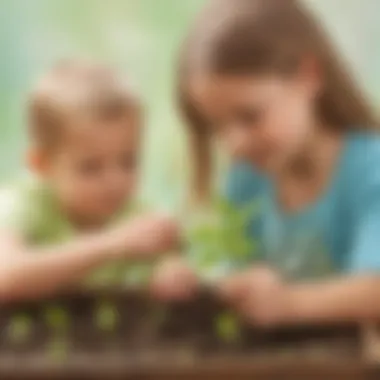Engage Kindergarten Minds: Spring Science Activities to Explore


Fun Activities Ideas
Spring is a vibrant season full of growth and exploration, making it the perfect time to immerse kindergarten children into the wonders of science. Through a variety of fun activities, young learners can engage in hands-on experiences that spark curiosity and learning. From indoor experiments to outdoor adventures, arts and crafts, and even cooking and baking projects, there are endless opportunities to cultivate a love for science.
Indoor Activities
Indoor activities provide a cozy setting for young scientists to conduct experiments and explore scientific concepts. Simple activities like creating a mini greenhouse using a plastic bottle, potting soil, and seeds can teach children about plant growth and care. Additionally, setting up a nature-inspired sensory bin with items like leaves, flowers, and rocks encourages sensory exploration and observation.
Outdoor Adventures
Venturing outdoors opens up a world of possibilities for kindergarten science enthusiasts. Nature walks offer opportunities to observe changes in the environment during spring, from budding flowers to chirping birds. Children can create nature journals to document their findings and develop a deeper connection with the natural world. Engaging in bird watching or bug hunting activities also allows them to appreciate biodiversity and learn about different species.
Arts and Crafts
Art and science intersect in engaging ways through creative projects that encourage experimentation and imagination. Crafting a paper plate sun catcher using translucent paper and colors mimics the colors of spring, teaching kids about light and color mixing. Building a rain cloud in a jar with shaving cream, water, and food coloring demonstrates the water cycle in a visually captivating manner.
Science Experiments
Simple science experiments can awe and enlighten young minds, fostering a love for scientific inquiry. Conducting a flower dissection activity enables children to explore the anatomy of flowers up close, identifying the different parts and their functions. Exploring sinking and floating concepts with sink or float experiments using various objects introduces the basics of buoyancy and density.
Cooking and Baking
Incorporating science into cooking and baking activities not only enhances culinary skills but also teaches valuable scientific principles. Baking soda volcanoes provide a hands-on approach to understanding chemical reactions, while homemade ice cream experiments demonstrate the concept of phase changes. Engaging in kitchen math by measuring ingredients and discussing ratios introduces basic math concepts in a delicious way.
Introduction to Spring Science
Why Spring Science Matters for Kindergarten
The importance of early science education
Early science education holds immense value in shaping young minds and laying a solid groundwork for future learning. By introducing kindergarteners to scientific concepts early on, we ignite their curiosity and encourage them to ask questions, observe the world around them, and seek explanations. This approach not only enhances their critical thinking and problem-solving skills but also instills a sense of wonder and curiosity about the natural world. Young children possess a natural inclination towards exploration and discovery, making early science education a suitable choice to channel their inquisitive minds. The unique aspect of early science education lies in its ability to spark enthusiasm for learning and build a strong foundation for future academic pursuits.


Benefits of hands-on learning
Hands-on learning plays a pivotal role in enhancing the learning experience for kindergarten children. By actively engaging in experiments, observations, and sensory activities, young learners can grasp scientific concepts more effectively and retain knowledge better. Hands-on learning allows children to explore various scientific principles firsthand, encouraging them to develop crucial skills such as problem-solving, critical thinking, and collaboration. The interactive nature of hands-on activities not only makes learning enjoyable but also facilitates a deeper understanding of complex concepts. This approach fosters a sense of independence and self-discovery among children, empowering them to explore and experiment with confidence. The hands-on learning approach offers a myriad of advantages in promoting holistic development and cognitive growth in young learners.
Exploring Nature
Exploring nature in the context of spring science for kindergarten is an essential element in providing young learners with a hands-on and immersive educational experience. By engaging in nature exploration, children can develop a deep appreciation for the natural world while honing their observation skills and nurturing their curiosity. It offers a platform for students to connect with the environment, encouraging a sense of environmental stewardship from a young age.
Observing Flowers and Plants
Observing flowers and plants plays a pivotal role in introducing kindergarteners to the diverse beauty and life cycles present in nature. By identifying different types of flowers, children can learn about various species, colors, and shapes, enhancing their visual recognition skills. Understanding plant life cycles provides insight into the growth and development stages of plants, offering a holistic view of nature's interconnected processes.
- Identifying different types of flowers: Identifying different types of flowers allows children to explore the intricacies of floral diversity, connecting colors and shapes to specific flower species. This activity fosters a sense of wonder and appreciation for nature's aesthetics, laying a foundation for future botanical interest.
- Learning about plant life cycles: Learning about plant life cycles enables students to grasp the concept of growth, from seed germination to flowering and fruit production. By observing these stages firsthand, children gain a deeper understanding of the importance of plants in the ecosystem, leading to a greater awareness of environmental conservation.
Studying Insects
Studying insects introduces kindergarteners to the fascinating world of small creatures and their essential roles in nature. By examining butterflies and caterpillars, children can witness the metamorphosis process firsthand, allowing them to observe the transformation from larvae to adult butterflies. Understanding the role of bees in pollination highlights the critical function of these pollinators in plant reproduction, emphasizing the interconnectedness of living organisms within an ecosystem.
- Examining butterflies and caterpillars: Examining butterflies and caterpillars offers children a chance to witness nature's miraculous transformation up close. Observing the life cycle of these insects promotes an appreciation for the beauty of metamorphosis and instills a sense of curiosity about the natural world.
- Understanding the role of bees in pollination: Understanding how bees contribute to pollination educates children about the symbiotic relationship between plants and pollinators. By exploring this concept, young learners develop an awareness of the intricacies of ecological balance and the significance of conserving insect populations for a sustainable environment.
Bird Watching
Bird watching provides kindergarteners with an opportunity to explore the avian world and learn about different bird species and their behaviors. By identifying common bird species, children can familiarize themselves with local wildlife, enhancing their bird recognition skills. Exploring bird migration patterns introduces students to the concept of seasonal bird movements, showcasing the incredible journeys birds undertake during migration.
- Identifying common bird species: Identifying common bird species allows children to appreciate the diversity of birds in their surroundings, promoting respect for wildlife and encouraging a sense of environmental awareness. This activity also cultivates a sense of responsibility towards protecting bird habitats and conserving biodiversity.
- Exploring bird migration patterns: Exploring bird migration patterns educates young learners about the impressive feats of avian migration, demonstrating the remarkable abilities of birds to navigate vast distances. Witnessing migratory birds in action sparks fascination and curiosity, inspiring children to delve deeper into the study of bird behavior and ecology.
Simple Science Experiments
Simple science experiments play a crucial role in the academic development of kindergarten children. By engaging in hands-on activities, these young learners not only enhance their curiosity but also develop critical thinking and problem-solving skills. The article explores various simple science experiments that are tailored to the capabilities and interests of kindergarten students. These experiments serve as foundational experiences for understanding scientific concepts in a fun and interactive manner, making learning enjoyable and accessible at an early age.
Water Cycle Demonstration
Creating a mini water cycle model


Creating a mini water cycle model is a pivotal part of the science curriculum for kindergarteners. It offers a tangible representation of the water cycle process, allowing children to observe and understand evaporation, condensation, and precipitation in a hands-on way. This experiment is crucial in illustrating the continuous movement of water on Earth and helps students grasp the concept of natural cycles. The simplicity of this model makes it a popular choice for introducing young minds to basic scientific principles in an engaging and memorable manner.
Understanding evaporation and condensation
Understanding evaporation and condensation is a fundamental aspect of the water cycle demonstration for kindergarten students. By witnessing water evaporate and then condense back into liquid form in the mini water cycle model, children can comprehend these transformative processes in a visual and captivating manner. This experiment not only teaches scientific concepts but also instills a sense of curiosity and wonder about the natural world. By observing and discussing evaporation and condensation, young learners develop a solid foundation in meteorology and environmental science.
Growing Seeds
Planting seeds and observing growth
Planting seeds and observing their growth is a hands-on activity that brings the wonders of nature into the classroom. Kindergarten children get to experience the magic of germination, seedling growth, and plant development firsthand. This experiment fosters an understanding of the plant life cycle and allows students to witness the impact of various factors on seed growth, such as light, water, and soil. By nurturing seeds and observing their progress, young learners develop a deeper appreciation for the environment and the power of nature.
Exploring factors that affect plant growth
Exploring the factors that influence plant growth is a valuable component of the kindergarten science curriculum. By experimenting with different variables like sunlight, water, and temperature, students can observe how these factors impact plant development. This hands-on approach not only enhances children's understanding of horticulture but also cultivates their investigative skills and scientific reasoning. Through exploring the complexities of plant growth, kindergarteners learn to ask questions, formulate hypotheses, and draw conclusions based on empirical evidence.
Exploring Shadows
Using sunlight to create shadow play
Utilizing sunlight to create shadow play is an engaging and educational activity for kindergarten students. By manipulating light sources and objects, children can observe the formation and movement of shadows, fostering an understanding of light and its interactions with solid objects. This experiment encourages creative expression and exploration of spatial relationships, allowing students to experiment with shadow shapes and sizes. Through hands-on shadow play, young learners develop a concrete understanding of how light behaves and how shadows are formed, laying the foundation for future learning in optics and physics.
Learning about the concept of light and shadow
Delving into the concept of light and shadow exposes kindergarten children to the fascinating principles of optics and illumination. By conducting experiments that explore the properties of light and shadow, students can investigate topics such as transparency, reflection, and refraction in a practical and engaging manner. This hands-on approach not only demystifies complex scientific concepts but also encourages critical thinking and problem-solving skills. Through observing and manipulating light sources and objects, young learners develop a deeper appreciation for the physics of light and its transformative effects on the world around them.
Weather Observations
Weather observation is a crucial aspect in the realm of spring science exploration for kindergarteners. Understanding and analyzing weather patterns not only nurtures a child's scientific curiosity but also instills a sense of awareness about the natural world surrounding them. By engaging in weather observations, children develop observational skills, critical thinking abilities, and a deeper understanding of the environment's dynamics. The hands-on experience of tracking and recording weather data helps children make connections between scientific concepts and real-life phenomena. Additionally, observing weather changes can spark discussions about the impact of weather on ecosystems, seasonal variations, and the importance of climate in shaping the world around us.
Measuring Temperature


Using a Thermometer to Track Temperature Changes
The utilization of a thermometer to monitor temperature fluctuations is fundamental in introducing children to the concept of temperature measurement. By observing and recording temperature changes, kindergarteners can grasp the idea of hot and cold, understand temperature scales, and comprehend how temperature affects the environment. Using a thermometer cultivates precision in measurement, encourages scientific accuracy, and fosters a methodical approach to scientific exploration. The hands-on activity of tracking temperature changes enables children to analyze patterns, make comparisons, and draw conclusions based on empirical data.
Discussing the Effects of Temperature on the Environment
Delving into the effects of temperature on the environment allows children to explore the interconnectedness between temperature variations and ecological systems. Through discussions on how temperature influences plant growth, animal behavior, and weather conditions, kindergarteners develop a holistic perspective on environmental dynamics. Understanding the impact of temperature on the environment promotes environmental consciousness, sparks curiosity about climatic patterns, and encourages children to contemplate the delicate balance of nature. By discussing temperature effects, children learn to appreciate the intricate web of relationships in the natural world and recognize the significance of maintaining environmental equilibrium.
Creating a Wind Vane
Constructing a Simple Wind Vane
The construction of a basic wind vane introduces children to the concept of wind direction and encourages them to investigate the movement of air in their surroundings. Building a wind vane fosters hands-on learning, enhances spatial reasoning skills, and cultivates an interest in meteorology. The simple yet effective design of a wind vane allows children to observe wind direction easily, make connections between wind patterns and weather conditions, and engage in interactive experimentation. Constructing a wind vane empowers children to become amateur meteorologists, sparking curiosity about atmospheric phenomena and encouraging scientific inquiry.
Understanding Wind Direction
Exploring the principles of wind direction enables children to comprehend the role of wind in shaping weather patterns and influences on the environment. By investigating wind direction, kindergarteners develop an awareness of wind's impact on activities such as sailing, seed dispersal, and weather forecasting. Understanding wind direction sharpens observation skills, fosters critical thinking about atmospheric processes, and promotes inquisitiveness about the invisible forces that shape our environment. Engaging in activities that explore wind direction encourages children to appreciate the complexity of meteorological phenomena and ignites a passion for uncovering the secrets of the natural world.
Rain Gauges
Building a Rain Gauge to Measure Rainfall
Constructing a rain gauge offers children a practical introduction to measuring precipitation and understanding rainfall patterns. By building a rain gauge, kindergarteners learn about the volume of rainfall, express measurement in quantitative terms, and perceive the significance of accurate data collection. The hands-on experience of observing and recording precipitation data promotes scientific inquiry, enhances mathematical skills, and cultivates a sense of environmental stewardship. Building a rain gauge instills in children a sense of responsibility towards monitoring weather changes, analyzing climatic trends, and recognizing the importance of water in sustaining life.
Recording and Analyzing Precipitation Data
Recording and analyzing precipitation data enables children to engage in scientific data interpretation, draw conclusions based on empirical evidence, and make connections between weather patterns and environmental conditions. By maintaining a record of rainfall measurements, kindergarteners develop data analysis skills, discern patterns in weather behavior, and predict future precipitation trends. Recording precipitation data fosters a sense of scientific inquiry, promotes accuracy in data collection, and instills a methodical approach to environmental observation. Through analyzing precipitation data, children gain insights into the cyclical nature of weather events, appreciate the role of water in ecological systems, and understand the importance of sustainable water management.
Conclusion
Enhancing Kindergarten Learning with Spring Science
Fostering a Love for Science at a Young Age
Pioneering the love for science at a tender age is a transformative aspect of kindergarten learning. By igniting the spark of curiosity early on, children are propelled into a realm of exploration and inquiry that shapes their cognitive development. Fostering a love for science at a young age instills inquisitiveness, critical thinking skills, and a deep-rooted appreciation for the scientific method. This approach not only prepares children for scholastic challenges but also cultivates a lifelong enthusiasm for unraveling the mysteries of the natural world. Emphasizing this foundational aspect in the realm of spring science activities enhances the learning experience, making it both enriching and enjoyable for young minds.
Encouraging Exploration and Discovery in Nature
Encouraging kindergarteners to explore and discover the bounties of nature offers a gateway to holistic learning experiences. Through hands-on interactions with the environment, children develop a profound connection to the natural world, fostering a sense of wonder and stewardship. Encouraging exploration and discovery in nature invites children to observe, question, and draw conclusions, thereby honing their observational and analytical skills. By immersing young learners in the beauty and complexity of the outdoors, educators and parents alike provide them with a rich tapestry of educational opportunities that transcend traditional classroom settings. This approach sparks a sense of adventure and environmental consciousness, nurturing a generation of young minds poised to appreciate and protect the Earth's precious resources.



